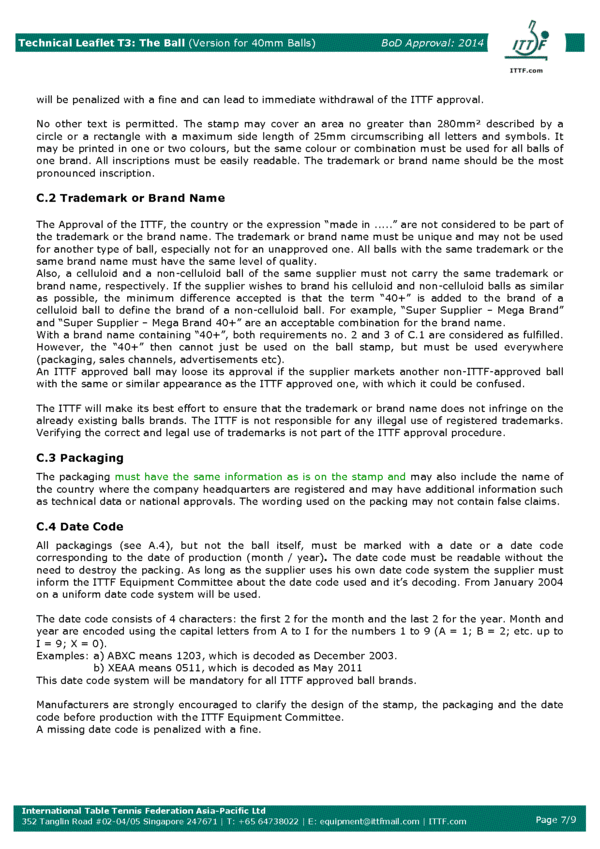larrythoman wrote: Torsten, can you tell us a little more about the random testing of retail samples that you describe on page 11 of your presentation? In particular, has this testing already begun, or will it indeed begin before 9/21 (end of summer, 2014) as described in your document?
Yes, the random testing started in September, because now we have a reasonable amount of retail stock to buy anonymously from (as planned, we try to compile a sample from different lots out of different countries and preferrably different continents).
Quote: If any testing has begun, can you please tell us how many different brands have been randomly tested and if there are any brands that did not pass all ITTF published standards and are due to have their approvals suspended?
As to #1, the random testing applies to all brands (poly and celluloid), therefore the amount of tested items is now rising and therefore I can not yet tell, how fast the whole thing will actually go.
As to #2, no. Failure of meeting the ITTF standards will become public only when, after the third failed test (see last question at bottom), the brand is suspended from the List of Approved Balls.
Quote: In my own non-professional testing of 8 different brands of poly balls, I've found 4 brands that did not meet ITTF published standards. Here's the results of my tests:
<Data sheet>
From the above results, we can see that:
Two brands did not meet the published standard for Weight Regularity of 0.03g--Cornilleau (0.037) and XuShoafa Sports (0.051).
Four brands surpassed the upper weight limit of 2.82g of any one ball--Palio (2.85 with 2 balls over), XuShoafa (2.95 with 4 balls over), Donic (2.84 with 1 ball over), and Cornilleau (2.89 with 4 balls over).
One brand was less than the minimum diameter allowed (40mm)--Donic (39.88).
One brand was over the Size Regularity limit of 0.06mm--Donic (0.065)
Now I realize that my personal tests are not official, and they were not conducted in a laboratory environment, but if the ITTF indeed found such results in their own tests, would those approvals face suspension as described in your document?
For weight, 1 out of 24 balls failing is allowed (see T3). Apart from that, Yes. Provided our lab would find such results, these would be failures in the sense of ITTF procedures. After the third failure, the brand is suspended without further notice.
Quote: In particular, can you explain this statement in T3--Statistical "outliers" are ignored when calculating means and standard deviations, but all values within a normal distribution but outside the permitted limits are included. What determines an outlier? How many outliers are permitted in the samples tested?
An outlier is a value that is so unlikely that it is regarded as an error in measuring, data capture or also an absolute singularity in the production line, not representing the "real" mass production. Such a value is derived by taking the values of, say, 1000 balls, calculating the mean and variance of a Gaussian Normal Distribution that fits these observations best - and then determining the value that will be exceeded with only an extremely low probability (usually the so-called "3 sigma interval"). For the current T3 this was done some years before I started. Since I started in May 2013, I have never seen an outlier in the lab results.
Quote: Your presentation includes the following statement on page 11 in reference to the random testing program--Repeated failure to meet the tolerance ranges is resulting in suspension of the approval. What happens to the approval after one failure? Two failures? Three failures? Exactly how many repeated failures is one brand allowed?
After the first failure a second sample will be tested (of course not after 2 years, but shortly) and the brand owner will be informed about that. The same happens after the second failure. If this third test then fails again, the brand will be suspended.
Quote: Besides my lack of the proper scientific laboratory environment, is there anything else I missed in my informal testing, and my calculations of results from those tests, that will allow me to obtain more accurate results? Nothing I would see at a first glance. There is no "trick" behind the process description in T3, especially in weight and diameter measurement. It's indeed mostly a matter of equipment.
Quote: Thank you for participating in this forum and enlightening us on how this random testing program is structured, conducted and what happens to brands that fail random testing.
Larry
You're welcome. 
|
